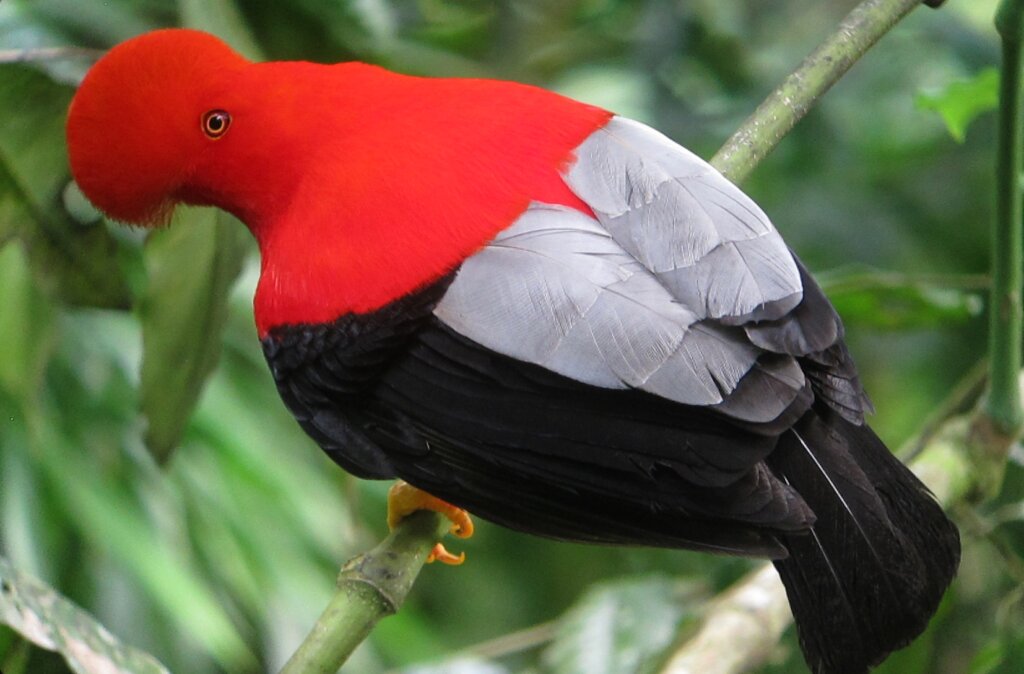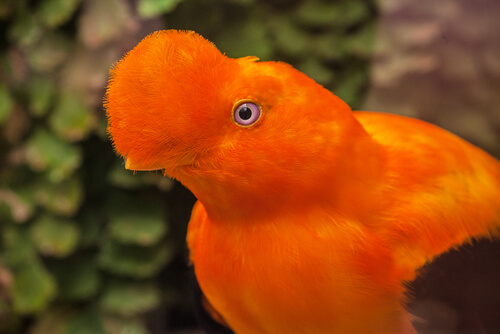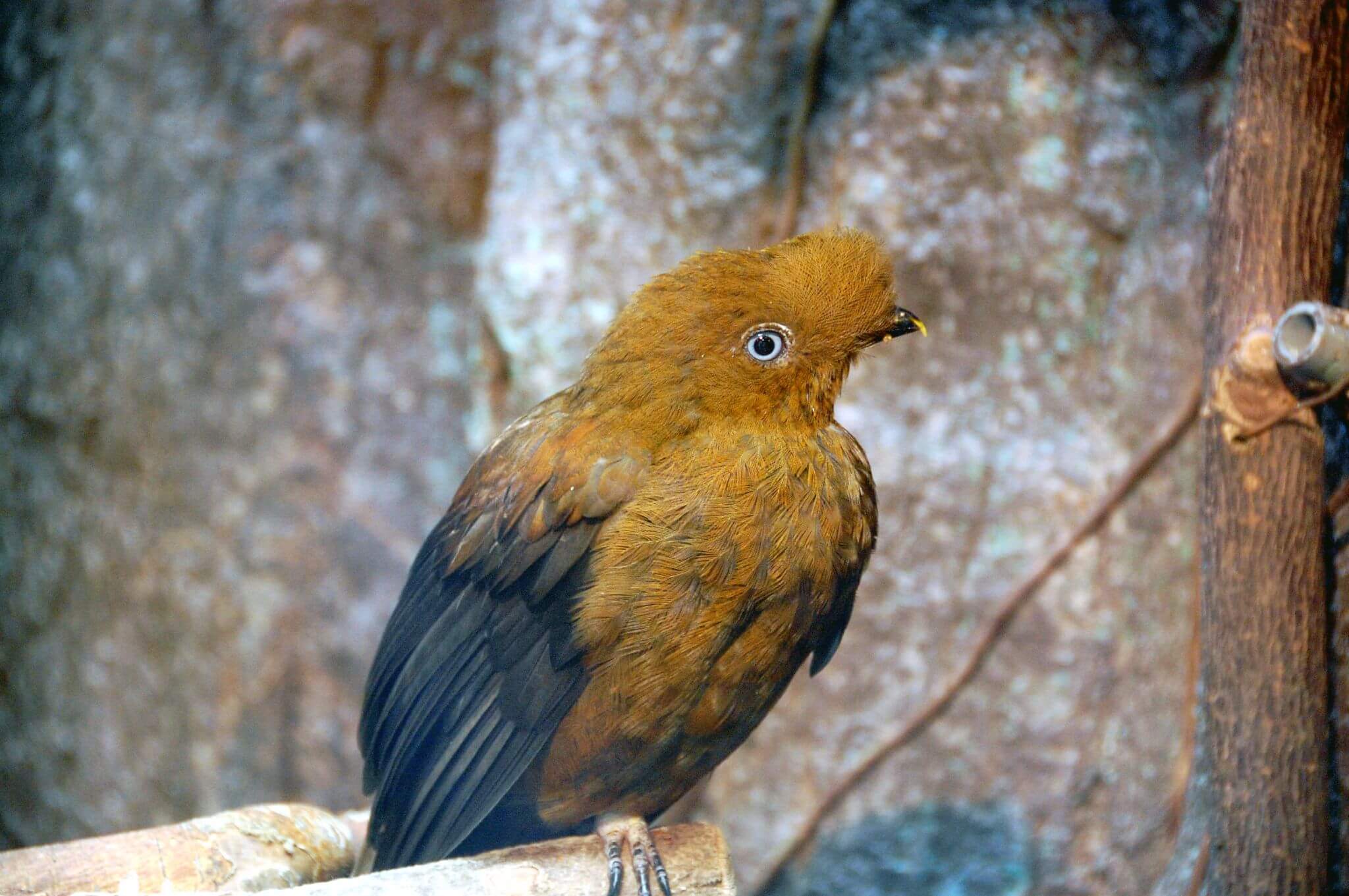The Cock-of-the-Rock: Habitat, Breeding, and Characteristics

The cock-of-the-rock is a beautiful bird native to South America that is characterized by its colorful and elegant plumage. In fact, thanks to its appearance, it’s considered one of the most iconic birds of the region and the national bird of Peru, which has also, unfortunately, encouraged the illegal capture and trafficking of this species.
The scientific name of this species is Rupicola peruvianus. It belongs to the family Cotingidae, which is known for several colorful and bright birds that live in tropical regions. Continue reading and discover everything you need to know about the cock-of-the-rock.
Habitat and distribution
The cock-of-the-rock has a rather restricted distribution, as it’s only found in the rocky areas of the northern Andes Mountains . This means that it inhabits areas of average altitude ranging from 400 meters to 2500 meters (1300 to 8200 feet) above sea level.
This bird belongs to the cloud forest ecosystem, which enjoys high humidity and temperatures between 12 and 23 degrees Celsius (54 to 73 degrees Fahrenheit). These characteristics allow the growth of a vast amount of jungle plant species.

Physical characteristics of the cock-of-the-rock
The cock-of-the-rock averages between 30 and 35 centimeters (12 to 14 inches) in length. Both its legs and beak are small, but at the same time, they’re resistant and hard. In addition, they have a disk-shaped crest that covers and hides almost the entire beak, which is the most outstanding feature of the species.
They exhibit obvious sexual dimorphism, so it’s easy to distinguish between the two sexes with the naked eye. As in other types of birds, the male has the brightest plumage, with a combination of orange, red, silver, and black tones. The female, on the other hand, has a darker and more opaque appearance, with a combination of brown and black tones.
Likewise, the color of the extremities (legs and beak) also varies according to the sex of the bird. In the case of males, they are bright shades of yellow or orange. However, females have black or brown colors that are less showy and are in accordance with the tones of their plumage.
Cock-of-the-rock subspecies
The Andes Mountains serve as a biological barrier that prevents communication between certain populations of this bird. This has generated a speciation phenomenon that has divided it into several subspecies according to their location. The world database Avibase currently recognizes 4 subspecies of the cock-of-the-rock:
- Rupicola peruvianus sanguinolentus: This variety is distributed between western Colombia and northeastern Ecuador.
- Rupicola peruvianus aequatorialis: This one’s habitat ranges from western Venezuela, through central-eastern Colombia to eastern Ecuador and Peru.
- Rupicola peruvianus peruvianus: Found in central Peru and near southern Junin, Buenos Aires.
- Rupicola peruvianus saturates: This subspecies is distributed in southeastern Peru and westward into Bolivia.
Behavior
Despite being a showy and beautiful bird, the cock-of-the-rock is a secretive specimen that prefers to stay hidden most of the time. It’s a diurnal species, so it performs most of its activities during the morning and evening. It tends to choose rocky areas with immediate access to resources such as water and food to avoid moving around too much.
Although they belong to the group of songbirds (Passeriformes), this species rarely uses its vocalizations. In fact, it could be said that their song is almost exclusive to the mating season, since they rarely use it as a warning against their enemies.
Cock-of-the-Rock diet
The cock-of-the-rock’s diet is based entirely on the consumption of fruits (frugivores), which are quite plentiful in their habitat. In addition, because its environment is always humid, the trees produce fruits throughout the year. And, as if that weren’t enough, when it digests its food, its waste contains the seeds of plant species, which helps to disperse the seeds and regenerate its ecosystem.
It should be noted that the diet of the cock-of-the-rock changes as they grow, as while they are chicks they need a large supply of proteins. These nutrients are provided through the ingestion of different insects. However, as soon as they finish their development and become independent, they’ll modify their diet and start eating only fruits.
Reproduction
The cock-of-the-rock is a polygamous bird that changes its mate in each reproductive cycle. The breeding season usually begins in October with the courtship dance by the males. During this season, all males in the flock gather to sing and display their plumage in order to attract the attention of the females.
Once the female chooses her mate, copulation takes place. However, after this moment, the male will abandon the female and it will be up to her to carry out the process of raising her offspring. To begin with, she will choose a rocky crevice or cave near a water source as a nest. After that, she’ll line the interior with moss and lichens to keep warm.

During the month of November, the female will lay her eggs and begin incubation. This process lasts approximately forty days, although the chicks will depend on their mother for at least another three months after hatching.
Although it’s true that the male doesn’t help in the upbringing of his offspring, the reality is that he protects them by being away from them. The father’s showy coloration may signal the location of the nest to predators, so his offspring are more likely to survive if their “father” doesn’t care for them. In contrast, the female’s dull plumage helps her to go unnoticed and blend in with the rocky environment.
As you can see, the cock-of-the-rock is a peculiar and rather curious species. In addition to its exuberant coloration, it has a complex natural history that stands out even among other tropical birds in the region. This largely goes to explain why it is considered one of the most beautiful birds in the world.
All cited sources were thoroughly reviewed by our team to ensure their quality, reliability, currency, and validity. The bibliography of this article was considered reliable and of academic or scientific accuracy.
- Stevens, H. C., Re, B., & Becker, C. D. (2020). Estimating survival for Andean Cocks-of-the-rock (Rupicola peruvianus) at a lek in Ecuador. The Wilson Journal of Ornithology, 132(3), 784-790.
- Maillard, O., & Caballero, E. (2003). Nidificación del Gallito de la Roca (Rupicola peruviana) en el Valle de San Onofre, Cochabamba, Bolivia. Ornitologia Neotropical, 14, 263-265.
- Sistema Nacional de Información ambiental. (sf). Rupicola peruvianus. Recuperado el 11 de octubre de 2022, disponible en: https://sinia.minam.gob.pe/contenido/rupicola-peruvianus
- Avibase. (sf). Andean Cock-of-the-rock: Rupicola peruvianus (Latham, J 1790). Recuperado el 11 de octubre de 2022, disponible en: https://avibase.bsc-eoc.org/species.jsp?lang=EN&avibaseid=33440684D62482BF&sec=summary
- Huamán, K. (2018). INFLUENCIA SOCIAL EN LA PERMANENCIA DEL HÁBITAT DEL RUPÍCOLA PERUVIANA EN EL PARQUE NACIONAL YANACHAGA CHEMILLEN-HUAMPAL-OXAPAMPA. (Tesis de grado, Universidad Nacional Daniel Alcides Carrión)
- Iannacone, J. (2004). El Gallito de las Rocas “Ave Nacional del Perú”: Comentarios. The Biologist (Lima), 2(1).
